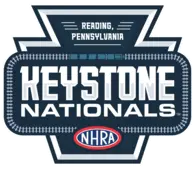

Something old, something new

A lot of things make the Chevrolet Performance U.S. Nationals the must-see event that it is, and two of Indy’s most notable features are events that put NHRA Sportsman racers front and center. Each year, the Mopar Hemi Challenge and, more recently, the School of Automotive Machinists & Technology NHRA Factory Stock Showdown have helped contribute to the mystique of the sport’s most prestigious event.
The Mopar Hemi Challenge and SAM Tech Factory Stock Showdown are similar events that feature heads-up racing for NHRA class cars, but there are also distinct differences. The Hemi Challenge, featuring '68 vintage Plymouth and Dodge factory race cars, honors NHRA’s heritage, and the SAM Tech Factory Stock Showdown represents the sport’s present and future by showcasing the latest technology from Ford, Mopar, and Chevrolet in the form of their popular Cobra Jet Mustang, Drag Pak Challenger, and COPO Camaro factory race cars.
Some probably thought that the Mopar Hemi Challenge would lose some of its luster after Charlie Westcott Jr. parked his all-conquering War Fish Barracuda and went Pro Stock racing, but that clearly hasn’t been the case. For the better part of a decade, Hemi fans headed to Indy wondering, “Can anyone stop Charlie?” and more often than not, the answer was no. Today, that question has been replaced by “Who’s the favorite?” because in Westcott’s absence, parity has returned to the SS/AH class.
During qualifying, Bucky Hess claimed the top spot, and it began to look as if the popular auto-body-shop owner might finally get his second Hemi Challenge victory. Hess, who won the inaugural Mopar-backed event in 2001, arrived in Indy with high hopes after impressive runs in his Kandy Kuda, which is powered by a Hemi engine built by Pro Stock ace Jason Line.

Hess made his way to the semifinals, where disaster struck. He was well ahead of Stephen Hebert and appeared headed for a berth in the final round when his engine expired. Oil then got under the rear tires, and Hess became a helpless passenger while his show-quality Plymouth turned sideways and smacked the wall. Hess wasn’t hurt, but his race car, perhaps the nicest and most detailed race car on the property, suffered significant damage.
With Hess out of the running, Hebert advanced in his Reher-Morrison-powered Secretariat Barracuda to take on second-generation racer Jimmy Daniels, who was driving father Jim’s Dodge Dart. Daniels, 20, had reportedly made just a handful of passes in the family’s 160-mph Dodge before entering his first Mopar Hemi Challenge race, but one would never have known it by watching his runs. Despite his lack of experience, Daniels finished the job and won the $15,000 top prize after Hebert fouled in the final round.

Daniels’ Dodge is powered by a Hemi engine that was built by David Barton, who was a central figure in the SAM Tech Factory Stock Showdown in Indy. Heading into the final event of the four-race series, there was no reason to think that anyone would be able to stop Barton in his quest to run the table. As a quick history lesson, Barton debuted his new Gary Wolkwitz-owned COPO Camaro in March at the Gainesville opener and dominated the competition. He went on to win the events in Englishtown and Norwalk and in the process made the sport's quickest and fastest Stock eliminator run with an 8.256, 165.58 blast in Englishtown.
Intent on completing the sweep in Indy, Barton got off to a great start when he qualified No. 1 for the exclusive eight-car field with an 8.339, nearly a tenth quicker than second-ranked Chuck Watson’s 8.409. Eventual Factory Stock champion Chris Holbrook was lurking in third with an 8.412 from his '16 Cobra Jet.
Most expected Barton to complete the four-race sweep, but the event took on a very different look during the first round of eliminations. Barton took care of business with an 8.442 in his win over Ryan Herem, who was wheeling the COPO Camaro normally driven by FOX TV personality and two-time NHRA Comp champ Bruno Massel. Barton’s run, however, was overshadowed by the performance of Holbrook, who drove his Varsity Ford Cobra Jet to an astounding 8.234, 165.17 in his win over Jordan Pennington’s COPO Camaro. It was a run that nobody saw coming, including Holbrook, who had admittedly struggled during qualifying with his new combination. Holbrook later admitted that a late-night text from fellow Cobra Jet racer Kevin Skinner pointed him in the right direction and led to his historic run.

Barton put up a good fight in the semifinals, but his 8.36 best was not enough to handle Holbrook’s 8.30 pass. Holbrook went on to finish the job by beating Stephen Bell’s COPO Camaro in the final round with a solid 8.314 effort.
In creating the SAM Tech Factory Stock Showdown, the goal of everyone involved was a program where the factories could showcase their latest technology, and to that end, the program has been a tremendous success. While Holbrook and Barton garnered most of the attention, it’s worth noting that the field for the Factory Stock Showdown continues to grow in both participation and quality of entries. This year’s Indy event attracted 24 cars, 20 of which were supercharged. To play on Sunday, it took a stout 8.54 just to make the eight-car field. That number would have comfortably won many Showdown races not too long ago.
As a final note, since the addition of the two specialty races, there’s been a noticeable boost in attendance in Indy Thursday and Friday morning, when Stock class eliminations and the Mopar Hemi Challenge take center stage. Since the arrival of the SAM Tech Factory Stock Showdown, there is also a much larger media presence at Lucas Oil Raceway at Indianapolis early in the week.




















































